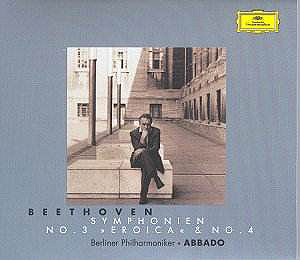Those who heard the BPO on its UK visit last Summer
will know that the orchestra is in great shape, even if Abbado was too
ill to be on the podium. During his reign, the sound has lost some weight;
the overwhelming lushness of the Karajan years is not so noticeable,
though still there when needed. Instead, we have a leaner sound, with
less of the extravagantly plush strings that could sometimes lead wind
soloists in the orchestra to force their tone simply to get through.
One of the most notable features of these fine performances is how effortlessly
details are heard, without any suspicion of ‘spotlighting’ from the
DG engineers. The result is, for example, an Eroica first movement bustling
with energy rather than proceeding with grandeur, reminding us that
Beethoven was still a young man in his early thirties when he completed
this astounding work. Abbado and the Berliners manage to keep the momentum
right up to the final terse Eb chords, giving the movement a glorious
sweep and unity.
The funeral march may worry some people; the tempo
marking is Adagio assai – very slow indeed. This version moves
far more freely than most; on the other hand, Abbado is very close to
the metronome mark in the score, quaver=80, and Norrington and others
have taught us to pay close attention to Beethoven’s markings rather
than regard them as the products of faulty early metronome technology!
This argument, however, is far less important than listening to what
works in musical terms, and on that basis, here is a gripping
performance of this sometimes overbearing movement. The playing of the
BPO’s principal oboe is glorious, and many hitherto unnoticed details
shine through – to take one example, listen to the low horns at Track
2, 10:16.
The Scherzo receives a fleet-footed and finely
characterised performance, while the finale is given one of the most
wholly convincing readings I’ve heard. The humour of the opening comes
over strongly, and although the oboe’s first announcement of the main
theme (track 4 1:44] suffers from the customary balance problems, this,
I fear, is more Beethoven’s fault than the performers’.
Such problems are rare; one is carried along on the
tidal wave of creative energy that Beethoven unleashes here. Irresistible
music-making that had me letting out a solo whoop of exultation at the
close!
The Fourth – possibly Beethoven’s least well-known
symphony, and certainly the most underrated – begins with another example
of Beethoven’s wicked sense of humour. This generally sunny and good-natured
work has the darkest and softest opening of any of the symphonies apart
from the 9th; Abbado captures this wonderfully well, and
then simply explodes into the Allegro, which is given a thrilling
performance, its wit and eventfulness explored to the full.
The slow movement (Adagio) is relaxed and spacious,
dispelling any possibility that Abbado’s fast speeds in the Eroica
are a stylistic ‘statement’. One senses there that he is aware of
the need to keep the music on its toes throughout the vast structures
that Beethoven creates. Here in the 4th, the music is more
concise and he can be a touch more leisurely when it suits him. Indeed,
I could do with a scherzo that is more explosive and dynamic
than Abbado’s. On the other hand, I appreciated his acknowledgement
of the fact that the Finale, often a scrambling Presto, is marked
by Beethoven Allegro ma non troppo (i.e ‘fast but not too much
so’- the ‘ma non troppo’ is quite emphatic). At this speed, not
only do the more expressive moments blossom, but the principal bassoon
can articulate the semiquavers of the main theme’s recapitulation without
dislocating his jaw!
A splendid issue, then, with a very strong coupling;
though some may find Abbado’s approach to the Eroica light-weight,
I do not, and would put it right up there with Carlos Kleiber’s great
VPO recording. The Fourth is less well represented on disc, and this
fizzing but affectionate reading is surely the modern recording to go
for. At over 79 minutes, it’s pretty good value, too.
Gwyn Parry-Jones


